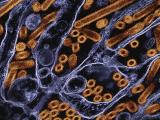Editor's note: This story was revised July 31 to clarify information about previous reports of H5N1 influenza viruses in Russia.
Jul 29, 2005 (CIDRAP News) – News services said today the avian influenza outbreak reported last week in Russia involves the dangerous H5N1 strain, while two more fatal human cases of the illness were reported in Vietnam.
A statement from Russia's Agriculture Ministry identified the flu outbreak in poultry in the Novosibirsk region of Siberia as H5N1, according to the Associated Press (AP).
"That raises the need for undertaking quarantine measures of the widest scope," the AP quoted the ministry as saying.
If the report is accurate, the outbreak apparently is the first significant H5N1 outbreak in Russia. The virus has been active in Southeast and East Asia since late 2003, causing more than 100 human cases with more than 50 deaths in Vietnam, Thailand, Cambodia, and Indonesia. However, this is not the first time an H5N1 virus has been identified in Russia, according to information from the United Nations Food and Agriculture Organization (FAO).
An FAO bulletin on avian flu, dated Dec 20, 2004, said that H5N1 viruses had been isolated from migratory birds in the Novosibirsk region "on several occasions" in the previous 4 years. However, an H5 avian flu virus isolated and sequenced from a mallard duck in the area in 2003 "was related, but not identical, to H5N1 avian influenza viruses currently circulating in domestic poultry in Asia," according to the report. The information was attributed to a US Department of Agriculture scientist. The report did not mention any actual disease outbreaks.
The outbreak in southwestern Siberia was first reported last week. Late last week, an official at a Russian disease research center identified the virus as H5N2, which is less virulent than H5N1 and has not infected humans. But in a Jul 24 report to the World Organization for Animal Health, Dr. Evgueny A. Nepoklonov of the Ministry of Agriculture Moscow said the virus had been identified only as an H5.
Earlier reports said the disease had killed hundreds of geese, ducks, turkeys, and chickens in nine villages. No human cases have been reported.
News of the Siberian outbreak comes about 2 months after the first reports of an outbreak among migratory birds at the Qinghai Lake wildlife refuge in northern China. World Health Organization (WHO) officials who visited the site in June estimated that about 5,000 birds had died. They worried that birds leaving the refuge later this summer would spread the disease to distant places.
Two reports published in scientific journals earlier this month seconded that concern. A group of Chinese researchers writing in Science called Qinghai Lake "a breeding center for migrant birds that congregate from Southeast Asia, Siberia, Australia, and New Zealand." They said the outbreak posed a risk that H5N1 could become a global threat.
In addition to the Qinghai Lake outbreak, two poultry outbreaks were reported in June in China's northwestern province of Xinjiang, to the west of the wildlife refuge.
Two deaths in Vietnam
Two young adults in southern Vietnam died of H5N1 infection this week, according to an AP report today. The victims were a 24-year-old man from Tra Vinh province who died Jul 25 and a 26-year-old woman from Ho Chi Minh City who died Jul 27.
The information was attributed to Phan Van Tu, chief virologist at the Pasteur Institute in Ho Chi Minh City. He said samples from both people showed positive results yesterday.
With the two latest cases, Vietnam has had a total of 93 cases and 42 deaths since December 2003, according to CIDRAP's unofficial count. The WHO, which waits for official notification from the Vietnamese government before updating its numbers, currently lists 87 cases with 38 deaths.
Both victims had had contact with poultry, Tu told the AP. He said their deaths were the first reported human cases in southern Vietnam since January. The pattern of cases this year resembles that of last year, when human cases occurred in the winter but dropped off in the spring before recurring in the summer, Tu said.
WHO reports on Indonesian investigation
The WHO today moved closer to agreeing with Indonesian health officials that H5N1 flu was the cause of death for three Indonesians who died earlier this month. The agency said laboratory tests indicate that what killed an 8-year-old girl was a probable case of influenza A/H5.
The agency said test results for the girl's 1-year-old sister were still pending. Previously the agency confirmed that the girls' 38-year-old father died of the virus. Tests were being done at the University of Hong Kong and the US Centers for Disease Control and Prevention.
The WHO also said that genetic analysis of virus isolated from the father shows that it matches other H5N1 isolates from poultry in Java and does not show signs of reassortment—an exchange of genes with other viruses that could make it more infectious.
Authorities have not yet determined how the Indonesian victims became infected. The WHO said today that investigators found H5-infected bird feces in a bird cage across the road from the family's house, but samples from the pet bird inside the cage were negative for H5. "This is the first, and, thus far, the only, indication of a possible source of exposure. Other environmental sampling was negative," the agency said.
About 300 contacts of the three victims are still being monitored, and none have shown signs of illness, the WHO said.
See also:
Jul 29, 2005, WHO statement
http://www.who.int/csr/don/2005_07_29c/en/index.html



















